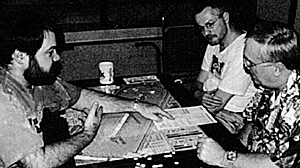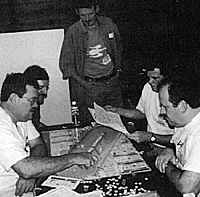 Tim Gritten introduces Philippe Briaux and Gary
Christensen to hippodrome mayhem. (HomerCon 2000, photos
by Chip Pharr)
Tim Gritten introduces Philippe Briaux and Gary
Christensen to hippodrome mayhem. (HomerCon 2000, photos
by Chip Pharr)
After some discussion at HomerCon, I figured that others might enjoy the thoughts we had regarding the various pregame purchase items and some game techniques. True to the "Embellishment" rule in the rule book, the first thing we did was expand the game into those areas where we wanted more detail in (namely in-chariot combat), so I'll present that material. Lastly, I'll include the known errata listing so that all have it available with the rest of this text.
For those keeping score, while it is true that I had never finished a race alive since before Origins, I was finally able (allowed?) to live through a race at the end of HomerCon. The others all swear they weren't actually gunning for the designer (yeah, right).
Purchases
There are several schools of thought on these items. I've changed my mind since release on spare whips. Before I wouldn't be caught dead without one. Now, I never bother to buy it. Why? I decided against ever making whip attacks against other players. I'll whip their horses, I'll ram them ... but I won't whip the driver. This has to do with whipping's double-edged sword-and one of the down-sides is that you might lose your whip. If you don't whip others, you can't lose your whip and that frees up money to spend on other things.
Everyone agreed the Talented Driver was worth his weight in gold--he was just not worth three coins. That is, everyone wanted one, but no one wanted to spend all three coins on it. This, of course, made the rest of us wary of any guy claiming to have won enough races to get a talented driver for free--to the point of making sure that anyone with a win or two under his belt never came out alive!
The Gods were another favorite (of the younger set, who were the only ones able to get their claws on it). This led to the technique of buying up the Entertainment only to hold it in reserve as a threat to anyone who dared reach for the Gods. Honor among thieves!
I tried a War Chariot once, but decided I'd rather spend those two coins on other things. Being able to ram better than others is kind of cool ... just not 2 coins worth of cool.
Fresh horses were a real winner. They are not only very helpful in the race (especially once everyone starts to develop some fatigue in the latter laps), but a real bargain, too, at just one coin. I'd opt for this one every time.
Nobody went out of their way to get the Drugged Teams or Sabotage. The drugs were probably deemed too costly for what they did while sabotage seemed to encourage revenge, and most didn't want to be seen as the first to draw first blood. Maybe in future games where the grudges are better developed ...
Running with the Entertainment on your head is a real pain. In one race I had it applied to me and I had no countering effect; Rod Miller got it once but had a talented driver to compensate. It was a real drag (the -1 to skid rolls, especially), but a player can learn to deal with it if he plays a tight game (not me, I diedas usual).
For the weapons, the sling and net got a rap of "not worth it." The sling I could understand (useless in close and the range doesn't make up for it), but the net perplexed me. So, I decided to get a net in a later game. When I finally decided to use it (in the last lap of a race), three or four net throws later we were all on foot on the track (all the teams got away). This led to my slogan:
It's all fun and games until someone pulls out a net!
Suffice it to say, I think the net, used at the right time, is a pretty cool weapon.
I like both the sword and the trident. The sword can't be beat when it comes to the advanced capture rules below. The trident comes in handy to poke other players as you go by (much like a whip, but without the downside).
Running in the Rear
Several of us tried the conventional wisdom of those who first see the Underdog Boost rule: "OK, I won't try tobe in front." This is good at keeping your fatigue down (as long as you are conservative in your whip and speed selections), and you can gain a significant advantage if the other players can be goaded into destroying each other while you cruise in the rear. This seems to work until the pack figures out what is going on (which seemed to take longer than I expected).
Once one or more of the others realize what you are up to, they'll pull back with you (negating your fatigue advantage) and refuse to do your bidding of wrecking each other (negating that advantage as well). With these adjustments in the rest of the pack, the guy lagging will have to maintain a more competitive position in the pack (he can't count on his fatigue advantage to let him make up for lost ground in the last lap) and the race goes back to "normal."
All in all, I'm very happy with the cumulative effects of the underdog boost and cocky leader rules. Most Circus Minimus games (where drivers knew how to handle their chariots and didn't flip in the first laps because they entered a turn too fast), ended with a neck-n-neck finish decided on the last move. That is the point of those rules-to keep the pack together.
Using the Skid...
Several of us (myself included) tried to take advantage of the extra re-face in a hard skid to make the corner easier at high speed. This is done by properly positioning your chariot so that a hard (or dangerous ... ) skid will merely help you along the way. This is only viable when you have little or no damage (a flip can ruin your whole race).
That's the theory. In practice, I've found that just when you need it the most, you won't get that extra re-face and you'll end up careening off in some odd direction wasting time and unable to turn again without getting zapped when you don't want it. This leads to all sorts of fishtailing around (like what happened to Chris Volny, who wasted his whole move, gathered a ton of turn markers, and didn't seem to make any progress at all in one move).
As a technique, it didn't work all that often and screwed up the player so much when it didn't; it wasn't worth trying again. This little technique is too smart by half.
Advanced Chariot Capture Rules
These are optional: use them instead of the regular rules for chariot jumping/capture if you like. We all find them to be a great hoot. In any case where a dismounted charioteer tries to get aboard another manned chariot (by jumping off the median or during the corpse move (moving the two spaces available to the running guy), roll one die to see if the attempt was successful. On a 5 or 6, the running charioteer successfully mounts the chariot (original driver remains in place); on any other roll, the runner remains in that space, dismounted as before. There is no limit to the number of charioteers who can be in one chariot (but I've never seen more than two).
The chariot's owner (the guy driving it when somebody jumps in) continues to drive his chariot normally (beware of the weapon restrictions based on Control selection: you can choose hard whip, just don't expect to use your sword, too). The chariot behaves normally for the owning player.
During each move with such an arrangement in play, the "corpse" (the driver who jumped in) attacks once in his move, or he can jump off and give up. During the chariot's move, the driver moves normally, and may attack the riding guy once or jump off himself.
If (when?) one of the two guys gets killed in the fist fight, drop the corpse on the track at that point. The fist fight continues each move until someone is killed or gives up.
 At HomerCon 2000, Joseph Vanden Borre (standing)
watches (left to right) Ken Thurston, Carl Martz, Jim
Lauffenburger, and Bob Antonacci race
At HomerCon 2000, Joseph Vanden Borre (standing)
watches (left to right) Ken Thurston, Carl Martz, Jim
Lauffenburger, and Bob Antonacci race
Circus Minimus Errata (3 Oct 00)
1. Just so it is clear, there are essentially two "phases": Corpse Movement and Regular Movement. Corpse Movement includes any loose horses, unmanned chariots, and running drivers. Regular Movement includes only manned chariots. In each phase, the pack order applies (front to rear, inside to out). In unresolved ties (two running drivers at the end of the median), flip a coin to see who goes first.
2. Appeal to the Gods gives 6 re-rolls, not three as mentioned in the rules at one point (the other entries are correct).
3. Jumping into chariots occurs only during the foot guy's move, not "as they go by."
4. The whip opponent rule (rule J5) is wrong in saying you use the Damage Table; the Whip Attack Table is correct.
5. When you whip another player's horses, apply that speed increase as the very last control function (after the player does everything he can think of to slow down).
6. Expand the description in rule J3e of how a running driver jumps onto the track from the median to include the following: "The dismounted driver can make his move by jumping down on the track into any of the hexes at or within 2 hexes of the end of the median. Running drivers cannot jump into the rectangular spaces near the end of the median; they can only jump into hexagonal spaces."
7. Per rule J2c, a wreck contains all extra equipment the driver might have had. Drivers who voluntarily dismount can take any equipment they might have with them. Drivers pulled from their chariot in a wreck (or a whip attack) leave all extra equipment in their chariot (or wreck), but do bring their whip with them (if they have one).
8. Each player (i.e. driver) can have only one chance to act in a given move. For example, a running driver might move as a corpse and get in an unmanned chariot. Even though he is now mounted, he does not also get to move in the regular movement cycle. Likewise, a driver that is tossed from his chariot after moving does not also get to move as a corpse.
Back to Table of Contents -- Operations #39
Back to Operations List of Issues
Back to MagWeb Master List of Magazines
© Copyright 2000 by The Gamers.
This article appears in MagWeb (Magazine Web) on the Internet World Wide Web.
Other military history articles and gaming articles are available at http://www.magweb.com